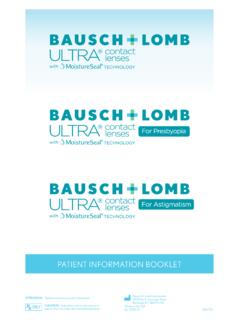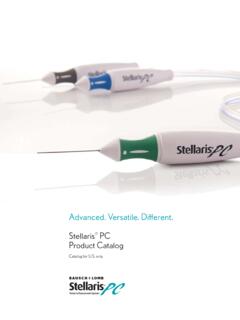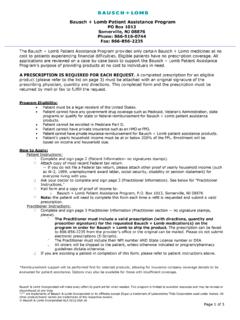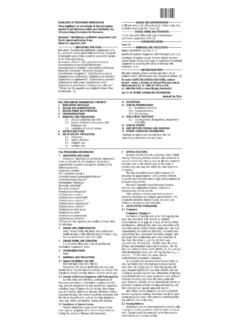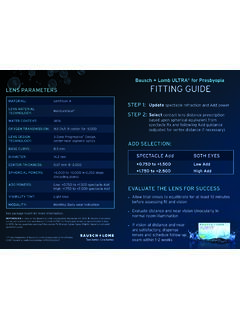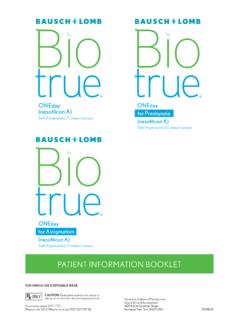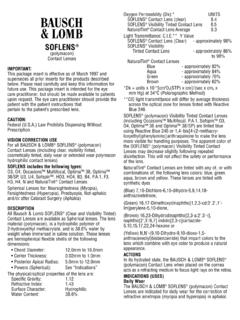Transcription of HIGHLIGHTS OF PRESCRIBING INFORMATION • Cataracts – …
1 FULL PRESCRIBING INFORMATION1 INDICATIONS AND USAGELOTEMAX is a corticosteroid indicated for the treatment of post-operative inflammation and pain following ocular DOSAGE AND ADMINISTRATIONI nvert closed bottle and shake once to fill tip before instilling one to two drops of LOTEMAX into the conjunctival sac of the affected eye four times daily beginning the day after surgery and continuing throughout the first 2 weeks of the post-operative DOSAGE FORMS AND STRENGTHS LOTEMAX (loteprednol etabonate ophthalmic gel) contains 5 mg/g of loteprednol etabonate, as a sterile preserved ophthalmic CONTRAINDICATIONSLOTEMAX, as with other ophthalmic corticosteroids, is contraindicated in most viral diseases of the cornea and conjunctiva including epithelial herpes simplex keratitis (dendritic keratitis), vaccinia, and varicella, and also in mycobacterial infection of the eye and fungal diseases of ocular WARNINGS AND Intraocular Pressure (IOP) IncreaseProlonged use of corticosteroids may result in glaucoma with damage to the optic nerve, defects in visual acuity and fields of vision.
2 Steroids should be used with caution in the presence of glaucoma. If this product is used for 10 days or longer, intraocular pressure should be CataractsUse of corticosteroids may result in posterior subcapsular cataract Delayed HealingThe use of steroids after cataract surgery may delay healing and increase the incidence of bleb formation. In those diseases causing thinning of the cornea or sclera, perforations have been known to occur with the use of topical steroids. The initial prescription and renewal of the medication order should be made by a physician only after examination of the patient with the aid of magnification such as slit lamp biomicroscopy and, where appropriate, fluorescein Bacterial InfectionsProlonged use of corticosteroids may suppress the host response and thus increase the hazard of secondary ocular infections.
3 In acute purulent conditions of the eye, steroids may mask infection or enhance existing Viral InfectionsEmployment of a corticosteroid medication in the treatment of patients with a history of herpes simplex requires great caution. Use of ocular steroids may prolong the course and may exacerbate the severity of many viral infections of the eye (including herpes simplex). Fungal InfectionsFungal infections of the cornea are particularly prone to develop coincidentally with long-term local steroid application. Fungus invasion must be considered in any persistent corneal ulceration where a steroid has been used or is in use.
4 Fungal cultures should be taken when Contact Lens WearPatients should not wear contact lenses during their course of therapy with ADVERSE REACTIONSA dverse reactions associated with ophthalmic steroids include elevated intraocular pressure, which may be associated with infrequent optic nerve damage, visual acuity and field defects, posterior subcapsular cataract formation, delayed wound healing and secondary ocular infection from pathogens including herpes simplex, and perforation of the globe where there is thinning of the cornea or most common adverse drug reactions reported were anterior chamber inflammation (5%), eye pain (2%), and foreign body sensation (2%).
5 HIGHLIGHTS OF PRESCRIBING INFORMATIONT hese HIGHLIGHTS do not include all the INFORMATION needed to use LOTEMAX (loteprednol etabonate ophthalmic gel) safely and effectively. See full PRESCRIBING INFORMATION for LOTEMAX .LOTEMAX (loteprednol etabonate ophthalmic gel) Initial Approval: 1998----------------------------INDICATI ONS AND USAGE --------------------------- LOTEMAX is a corticosteroid indicated for the treatment of post operative inflammation and pain following ocular surgery. (1)-------------------------DOSAGE AND ADMINISTRATION ------------------------ Invert closed bottle and shake once to fill tip before instilling drops.
6 Apply one to two drops of LOTEMAX into the conjunctival sac of the affected eye four times daily beginning the day after surgery and continuing throughout the first 2 weeks of the post-operative period. (2)------------------------DOSAGE FORMS AND STRENGTHS ----------------------- LOTEMAX contains 5 mg/g of loteprednol etabonate, as a sterile preserved ophthalmic gel. (3)-------------------------------CONTRA INDICATIONS ------------------------------LOTEMAX, as with other ophthalmic corticosteroids, is contraindicated in most viral diseases of the cornea and conjunctiva including epithelial herpes simplex keratitis (dendritic keratitis), vaccinia, and varicella, and also in mycobacterial infection of the eye and fungal diseases of ocular structures.
7 (4)-------------------------WARNINGS AND PRECAUTIONS ------------------------ Intraocular pressure (IOP) increase Prolonged use of corticosteroids may result in glaucoma with damage to the optic nerve, defects in visual acuity and fields of vision. If this product is used for 10 days or longer, IOP should be monitored. ( ) Cataracts Use of corticosteroids may result in posterior subcapsular cataract formation. ( ) Delayed healing The use of steroids after cataract surgery may delay healing and increase the incidence of bleb formation. In those diseases causing thinning of the cornea or sclera, perforations have been known to occur with the use of topical steroids.
8 The initial prescription and renewal of the medication order should be made by a physician only after examination of the patient with the aid of magnification such as slit lamp biomicroscopy and, where appropri ate, fluorescein staining. ( ) Bacterial infections Prolonged use of corticosteroids may suppress the host response and thus increase the hazard of secondary ocular infection. In acute purulent conditions, steroids may mask infection or enhance existing infection. ( ) Viral infections Employment of a corticosteroid medication in the treatment of patients with a history of herpes simplex requires great caution.
9 Use of ocular steroids may prolong the course and may exacerbate the severity of many viral infections of the eye (including herpes simplex). ( ) Fungal infections Fungal infections of the cornea are particularly prone to develop coincidentally with long-term local steroid applica tion. Fungus invasion must be considered in any persistent corneal ulceration where a steroid has been used or is in use. ( )-------------------------------ADVERSE REACTIONS ------------------------------The most common adverse drug reactions were anterior chamber inflammation (5%), eye pain (2%), and foreign body sensation (2%).
10 (6)To report SUSPECTED ADVERSE REACTIONS, contact Bausch + Lomb, a division of Valeant Pharmaceuticals North America LLC, at 1-800-321-4576 or FDA at 1-800-FDA-1088 or 17 for PATIENT COUNSELING INFORMATIONR evised: 08/2016 FULL PRESCRIBING INFORMATION : CONTENTS* 1 INDICATIONS AND USAGE2 DOSAGE AND ADMINISTRATION3 DOSAGE FORMS AND STRENGTHS4 CONTRAINDICATIONS5 WARNINGS AND Intraocular Pressure (IOP) Increase Delayed Bacterial Viral Fungal Contact Lens Wear6 ADVERSE REACTIONS8 USE IN SPECIFIC Nursing Pediatric Geriatric Use11 DESCRIPTION12 CLINICAL Mechanism Of Pharmacokinetics13 NONCLINICAL Carcinogenesis, Mutagenesis.
